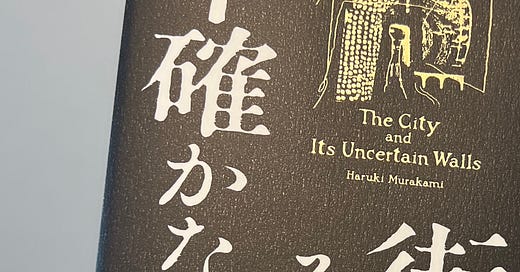This is How to Japanese, a monthly newsletter with something about Japan/Japanese and a dash of いろいろ.
日本・日本語: Inverted Sentences in the Latest Murakami Novel + My Review
It took me over two months, but my review of the new Haruki Murakami novel The City and Its Uncertain Walls is online over at Medium. I posted it there and not here because it got unwieldy and it didn’t feel fair to drop that in your inbox. If you’re interested, go check it out. Unfortunately, I cannot recommend the novel. It is not good.
One of the elements I looked at is Murakami’s use of 倒置 (tōchi, inversion). I’m not sure if it’s actual 倒置, but I think we can count it. Basically, 倒置 is when a grammatical element is given after an element it usually precedes. I think generally this occurs as a parenthetical within a single sentence. For example, 買ったよ、新作を (Katta yo, shinsaku o, I bought it, the new novel). This serves to identify (and thereby emphasize) something that would have otherwise been unspoken. Because so much can be left unspoken in Japanese, you can use 倒置 to specify subjects, objects, how something was done, when something was done, etc.
What Murakami does is follow a sentence with a separate dependent clause that adverbially modifies the prior sentence. I gave a number of examples in the review, but here’s another:
Koyasu closed his eyes for a moment. As though he were looking just then for the afterimage the onions left on the back of his eyes. He finally opened his eyes and continued his story.
子易さんはしばし目を閉じていた。網膜に残った葱の残像を今一度確かめるように。やがて目を開き、話を続けた。 (381-382)
Forgive the stilted translation. I don’t think it would be rendered quite this literally, but this does help express what’s going on with the Japanese. Murakami uses のように and みたいに in sentence-ending position this way 198 times in the book. (Yes, I counted.) In Hard-boiled Wonderland and the End of the World, he only uses these sentence structures three times. It feels like a notable shift in his writing, even from Killing Commendatore. I’d be curious to know what the numbers look like in those books and in books written by other contemporary writers. (And as for the onions…those are one of the more striking images of the bizarre that Murakami includes in the novel, but I don’t think he really uses it to do anything. It’s just an interesting painting sitting on the wall of an empty room, not really part of the collective exhibit readers might expect a novel to be.)
At any rate, it feels like Murakami really over-relies on this pattern. And as you can see in my review, のように and みたいに aren’t the only grammatical structures he uses to create 倒置. He uses て-form verbs as well as other constructions like にせよ.
Alas. Check out my full thoughts over on the final Murakami Season episode of the How to Japanese Podcast. I went on at length there. I think my biggest takeaway is this: In the long run (like, the very long run), Murakami will be considered a bad novelist, a decent short story writer, and a good nonfiction writer.
いろいろ
I had such high hopes for my review, but I think it ended up being only OK. Which is fine. I’m glad to be done with it. I briefly considered including a roundup of Japanese reviews of the novel. Shincho published seven reviews, including one by Yoshimoto Banana, but after perusing them, they didn’t really feel like the reviews I’m used to. All of them did more wrestling with ideas rather than evaluating. To confirm what I was seeing, I pasted this review in ChatGPT, asked it for a summary (which felt decent), and then asked it whether the review was positive or negative. It gave me this very interesting response, which I think suggests my instinct was correct:
I wrote about this on Twitter, but this book まいにち小鍋 (Everyday Small Pot) is the best recipe book I’ve found in a long time. I’ve made a bunch of the recipes and am looking forward to making more. It’s totally changed up my cooking game for the better. Highly, highly recommend.
Here’s my thread on Tears of the Kingdom TikTok videos. It’s having a moment on that app, and there are some very funny ones.
Speaking of Tears of the Kingdom, I wrote 1,000 words about it on the blog last month.






Wonderful post. Thank you, Daniel. I never knew there was a word for the inversion thing in speech, though it’s something that, in my experience as a learner of Japanese, you soon notice in everyday Japanese conversation but which does not appear in textbooks. Not in mine anyway, though admittedly that was, ahem, a “minute or two” ago for sure.